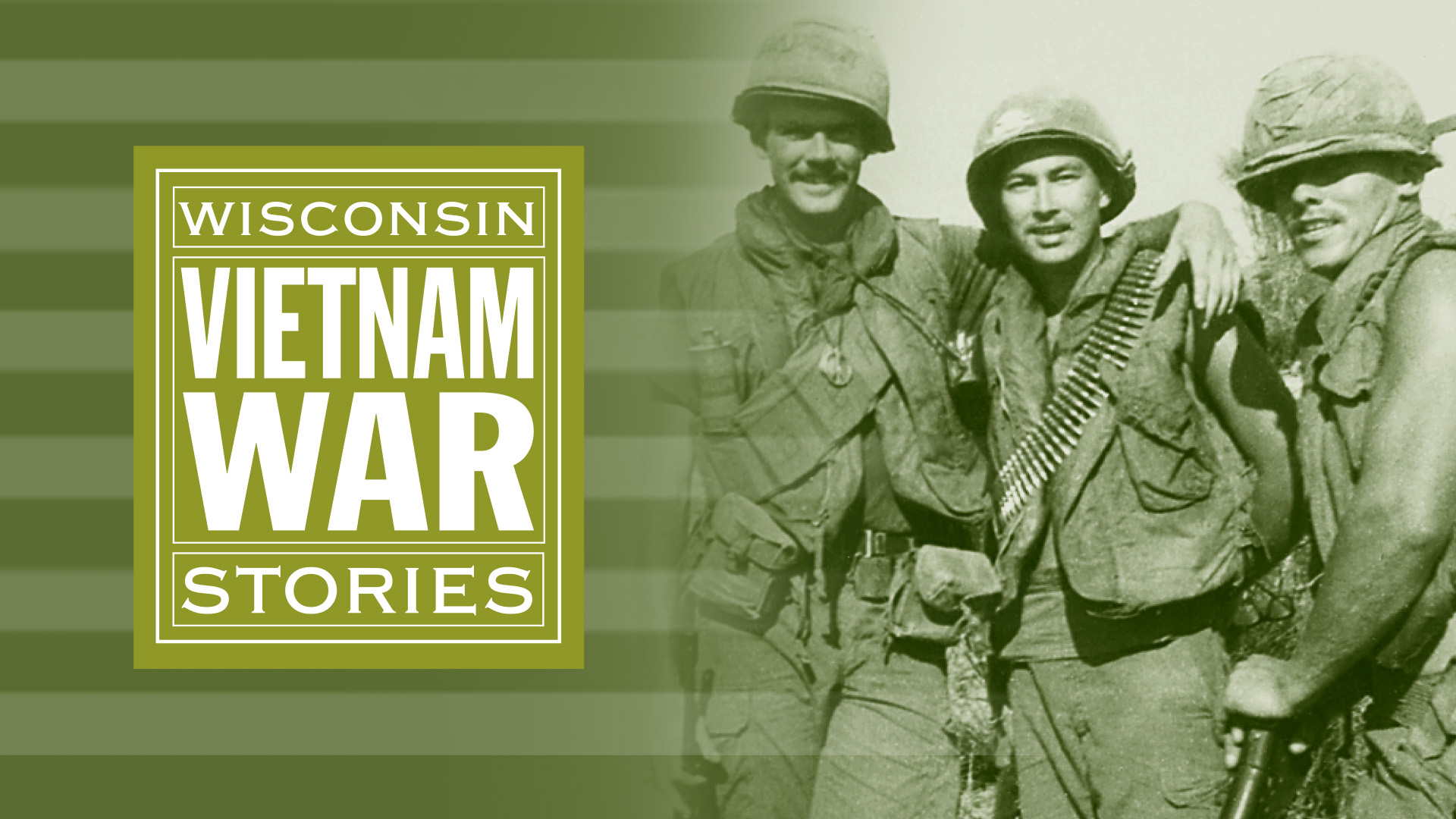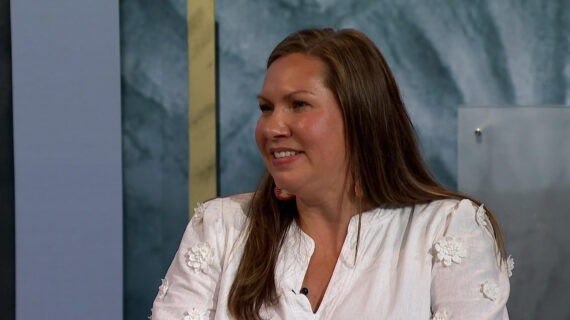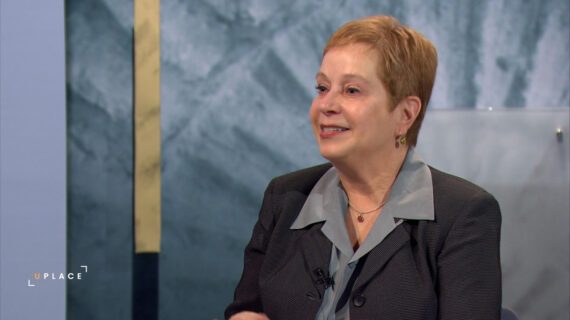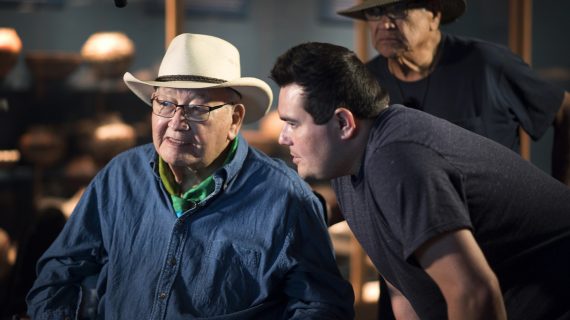So welcome to Wednesday Nite at the Lab. My name is Liz Jesse and I’m a Science Outreach Specialist at the UW-Madison Biotechnology Center. On behalf of the Biotechnology Center, UW-Extension and Cooperative Extension, Wisconsin Public Television, the Wisconsin Alumni Association and the UW-Madison Science Alliance I would like to thank you for coming out tonight to Wednesday Nite at the Lab. We do this every Wednesday night 50 times a year. Tonight it is my extreme pleasure to introduce June Dahl. She is a professor emerita of Neuroscience at UW-Madison School of Medicine and Public Health. Dr. Dahl completed her BA in chemistry from Macalester College in St. Paul Minnesota and she earned her doctorate in physical chemistry from Iowa State University. She arrived in Madison with her husband when he joined the UW-Madison chemistry department. In 1984 she was appointed to the Controlled Substances Board, Wisconsin’s drug Regulatory Authority. It was service on that board along with a bill introduced into Congress in 1986 to make heroin available for paying treatment for the dying that led to her focus on educational and policy issues directed at improving the management of pain. Tonight Dr. Dahl will provide a review of opioids and their use and she will address the importance of maintaining a balance so that efforts to reduce abuse of these drugs do not interfere with the appropriate medical use. Ladies and gentlemen please join me in welcoming June Dahl.
[audience applauds]
– So I selected this as the title of the comments I’m going to make to you tonight. “The Opioid Crisis: An Historical Perspective” and what I would like to do is define some terms starting with the word opioid since we’re going to talk about the opioid crisis. What are these drugs? And I suspect all of you know what they are. They relieve pain, they cause sedation, they suppress cough, they cause constipation and they include the illegal drug heroin and also a lot of pain medicines that are available by prescription. None of them is available over-the-counter at this point in time. And they’re drugs like oxycodone and hydrocodone and codeine and morphine and there are a whole bunch others. One of the points I would like to make is that some of these drugs contain other things besides opioids. And one of them that’s very commonly prescribed is Vicodin, which is hydrocodone and acetaminophen.
And the acetaminophen is a rather dangerous drug. If you take a lot of it you can have severe damage to the liver. Now that was a description of some of the opioids. I’ve just put this slide in very quickly to tell you that there are a lot of others and you can distinguish them one from the other by how long they last or by how they are given. So there are short-acting drugs and long-acting drugs and then they’re ultra short acting drugs. And the only one that’s really used a lot today in the ultra short-acting category is fentanyl, which can be given intravenously or transmucosally. Now when we talk about these drugs perhaps you can tell me how long do short-acting opioids produce pain relief? Do you know how–
– Two hours.
– Two hours! Somebody else got another number?
– Four.
– Four! Well you could both be right because how do we know how long a drug gives pain relief? You ask the patient. I always tell the students that every patient is an individual pharmacologic experiment. So you can’t just read a textbook or a manuscript and figure out how long it lasts. You have to ask the person. So some people get six hours of pain relief from morphine. But most get three to four and some may even get two. In the long acting category there’s a whole range of durations from eight hours to perhaps even as much as 24. And something like fentanyl doesn’t last long at all. You have to keep giving it in order to get an effect There also are antagonists. And has anybody here not heard of naloxone or Narcan? Everyone has because it’s used a lot to reverse the respiratory depressant effects of morphine and other opioids.
And another drug in this family is naltrexone. And you can see that there are a whole bunch of brand names there. Again that’s used for different purposes. And then they’re the new kids on the block and these are the abuse deterrent opioid formulations. And they’ve been put together to try to keep people from abusing this class of medicines. How well do you think they work? Well I would say that anybody who is determined to abuse a drug can figure out a way to circumvent the formulations. And so they aren’t abuse proof but that’s not a surprise to you. So that was the overview of opioids. But what about the word crisis? I looked that up in the dictionary. You all probably know because you’re more learned than I, what’s a crisis? Any event that’s going to lead or is expected to lead to an unstable and dangerous situation. And it can affect an individual or it can affect a group or a community or a whole society. And crises have damaging effects at various levels. Is there a crisis involving opioids? And what’s the evidence for that crisis? Well actually there’s more than one crisis relating to opioid analgesics. One of them relates to overdosage and deaths. And I’ve put some figures up here but you can’t really be certain about the numbers. How many people die of overdose in a year? It’s not certain and we get various numbers. But I want to compare the number of deaths with the number of deaths of soldiers who died during the Vietnam War and also the number of persons who died of car crashes back in 1972 when car crashes peaked in this country and then how many people died in 1995 because of HIV/AIDS infections. So you can see that the numbers for opioids are very large indeed.
So in fact there’s another crisis with opioids that I want to talk about. And that is the fact that concerns about their diversion and abuse is leading to their underutilization and that’s leading to people experiencing unrelieved pain. So what’s pain? It all starts with pain actually. And we get different feelings about what pain is depending upon the era in which we get information. If we look at the giants of ancient Greece, Plato and his student Aristotle. They considered pain to be an emotional not a sensory experience. And pain was an independent being that invaded our bodies, took it over. If you’ve had severe pain doesn’t that sometimes feel that way to you? Aristotle said that pain’s “like a spirit that enters through an injury”. This traditional view of pain as an external force has been a persistent one.
Pain is often seen as an act of God or of gods as a kind of punishment or a test of faith. And the word pain actually comes from the Latin that means penalty. During the Renaissance, Descartes took a different view and in the 1600s he refuted the idea that pain came from the outside. He proposed the pain was due to an internal mechanical process, that the body was a machine. And pain was a disturbance within the machine. And then we go to evolutionary theory where pain is a way that the body defends itself. And it reminds us to avoid the causes of pain in the future. The intensity should be proportional to the risk that the stimulus creates for us. However natural selection is rarely perfect so some things are disproportionately more painful than the risk they pose. And I ask you to think about the lowly paper cut. I find those extraordinarily painful. And think on the other hand about the real agony of gout. I found– probably can’t see this too well– but I found this online of course where everything is. And I can see this incredible red swelling. This is enormously painful. And I like this cartoon much better. You see this ugly little being. I like his tail and I don’t know why I think it’s a male rather than a female but this is the gout and you can see how he’s going after the joint.
And then we should consider the pain of what some have called wounded warriors. These are persons who are injured in conflicts. Seriously wounded soldiers were questioned after receiving their wounds by Lieutenant Colonel Henry Beecher. And these individuals had been injured during the invasion of Anzio in Italy. If you ask young kids about the Anzio beachhead invasion they have no idea what you’re talking about. But I suspect you folks do. What he found was that if he surveyed these soldiers 12 hours after their injuries that 25% of them said they had slight pain, 32% had no pain and 3/4 of them felt so little pain that they didn’t think they needed medication. The soldiers wounds released them from this horrendous situation which might ultimately threaten their whole being. This wasn’t the case with veterans of the Iraq War and it’s not the case with persons who are injured in accidents, industrial accidents that produce similar kinds of lesions.
Those persons are very vigorous in their demand, I should say, I wrote pursuit here, but it’s really demand for pain relief. And the International Association for the Study of Pain put these concepts together very nicely when they created a definition of pain in 1975. They recognized the dual nature of pain and said “it’s an unpleasant sensory and emotional experience associated with actual or potential tissue damage or described in terms of such damage.” That certainly captures very well the kinds of reports that we see from individuals who were injured in various situations. Now we need to talk because I was asked to do so, a little bit about the history of opioid analgesics themselves. The history of embracing and rejecting their use. How many times has this pendulum swung? One, two, three, four, 10, 12? What do you think? Actually the swing has really been fairly large and numerous. And so we need to look a bit about opium history. The earliest reference to opium growth and use was in about 3400 BC. That was even before I was born. By 1300 BC the Egyptians were cultivating opium and they named it on the basis of the capital of Egypt at the present that time which was Thebes. Hippocrates who is considered to be the father of medicine, noted way back when the pain-killing properties of opium. And around 330 BC Alexander the Great introduced opium to Persia and India. and then comes Paracelsus. Any chemists in the audience know about this individual. He is putatively the father of toxicology and he’s the person who actually compounded laudanum. Laudanum is 10% opium and alcohol. And that led me to ask the question is when did alcohol come into human use? Anybody got a guess? 10,000 years ago.
Because of course you don’t have to take the alcohol from some plant or anything like that. It’s produced when plants ferment so it’s pretty accessible if you look out for it. Thomas Sydenham who’s considered the father of English medicine or the British Hippocrates recognized the power of opium around 1680. He wrote a couple of things that I think are one statements that we ought to think about that I really adhere to at the present time. He said opium and I would substitute opioid analgesics is “one of the most valued medicines in the world which does more honor to medicine than any remedy whatsoever.” He also wrote that “among the remedies which it has pleased God Almighty to give to man to relieve his sufferings none is so universal and efficacious as opium.” Those words are still true today. And so in many ways these are God’s gift to humanity. What’s this? That’s a poppy! Isn’t that gorgeous? That’s the source of opium. Now how do we get opium from this poppy? Well not from grinding up the poppy leaves, not at all. But from waiting for the plant to dry and form these pods.
And notice that wonderful drip there? Opium comes from that juice of the poppy pods. And people can score these pods, open them up and the juice will run out. Now the poppy juice contains morphine and also contains codeine and thebaine. And thebaine is important because it serves as a raw material for the synthesis of other opioids. One of the opioids that’s got great attention all of the time is heroin. And heroin is actually diacetyl morphine and why is it so abused? Well because it’s less bulky than morphine and it’s easier to smuggle. What’s the source of morphine today? Where does it come from?
– [Man] The juice.
– The juice, that’s right! There is drugs that cannot be synthesized de novo in the laboratory and opioids are one category and cardiac glycosides constitute another category. I’m sure it won’t be long before there are synthetic processes to produce morphine in the laboratory. But right now that’s not the case. So here are some structures for chemists who love to look at structures. And there’s morphine, notice those two hydroxyl groups. And they get acetylated and the acetylation transforms that molecule to heroin. Down below morphine is methadone. You ever heard of that? It’s a long-acting orally effective drug it could also be given parenterally. Methadone was synthesized by a German chemist during the Second World War because their supply of natural opioids was cut off and they needed a very effective medicines to treat pain. Notice hydromorphone in the upper right-hand corner. And that’s very similar to morphine. It is in many ways except it’s more potent. Does that mean it’s more effective? No, it just means you give less of the drug to get the same pharmacologic effect. And notice down in the bottom corner is the drug naloxone. Many of you already knew what that drug was but I told you before this is an opioid antagonist. So you can see by simple transformation of the structure of morphine to naloxone, you get a compound that is an antagonist of opioid actions. Doesn’t have actions of its own. It’s just a blocker.
– [Man] Can I ask you why is that?
– Why is that?
– Yeah.
– I have no idea why that is. It has something to do with structure activity relationships but I can’t answer your question easily. It would take me about 20 minutes. But we can do that later. How’s that? Is it a deal? – [Man] Okay. [laughs] – I don’t think he really wants to have 20 minutes but he asked the question. So a little bit about opium history. Before 1800 crude opium was widely available in the United States and it was an ingredient in multi drug preparations. And of course as I’ve already told you in laudanum which was 10% opium in alcohol. And it was very valued for its calming and soporific effects. It was also a specific treatment for GI illnesses. Given that opioids cause constipation it’s an interesting balance to think about treating GI illnesses. It was a drug that was prescribed, well really supplied very freely by physicians in calm teething children and it also calmed hysterical housewives. Now I don’t know if it calmed hysterical house husbands or not [laughter] but I will look into that.
– [Man] Yes, yes it does.
– I’ve gotta find that.
– [Man] In a pill form.
– In pill form! A drug that calmed people down was very appealing because physicians had almost nothing to work with at that point in time. There weren’t effective agents, there wasn’t even aspirin. So that was the good times when there was opium. And it was freely available. So we’re talking about the history of embracing and rejecting the use. What happened? What happened was that morphine use became a booming business in the 1800’s in this country. It had been isolated from opium by a German pharmacist in 1803. And he named it morphia after Morpheus the Greek god of dreams. And manufacture of morphine salts started in 1832 and the hypodermic needle was perfected in the middle of the century. Wasn’t this wonderful for those persons who were serving in the Civil War? During the 1800s there was a dramatic increase in the consumption of morphine and the per capita peaked in 1896. just at the end of the century. And then the pendulum swung back.
Reaction to the freewheeling use of the 1800s. And in 1906 there was a Pure Food and Drug Act. In 1914 the Harrison Act which regulated and taxed the production, importation and distribution not only of opiates but also of cocoa products. And then in 1919 the Supreme Court outlawed addiction maintenance. And then in 1937 there was what was called the Marijuana Tax Act and marijuana was linked to other alarming drugs such as cocaine and heroin. So that was the era when marijuana became really bad stuff. And in the 20 years between 1930 and 1950 the severity of the anti-drug laws increased and it peaked in 1956 when there was the death penalty for the sale of heroin to minors. And I thought about that when I heard that Trump had recommended the death penalty for narcotic dealers in this country. I think that was the word that was used.
So now we look at some of the other perspectives. And here’s one about the use of medications for controlling pain in persons who are dying of cancer. This was published in 1941 in the Journal of American Medical Association. Dr. Lee wrote “The use of narcotics in terminal cancer is to be condemned if it can possibly be avoided. Morphine and terminal cancer are in no way synonymous. Morphine usage is an unpleasant experience to the majority of human subjects because of undesirable side effects.” Wow. “Dominate in these lists of unfortunate effects is addiction.” What about all those people who abuse these drugs because they really liked them? And then the pendulum swings again because an emphasis came on end-of-life care and that changed the perspective on the use of opioids. In 1948, Dame Cicely Saunders began her work in England and she applied the name hospice care to specialized care of the dying. That term actually goes back to medieval times.
It means a place to shelter weary or ill persons who have traveled long distances. The interesting thing was that Dr. Saunders used heroin to treat her patients who were dying. Remember heroin is diacetyl morphine. It’s a controversial way to give morphine. For some reason Dame Saunders thought that there was something special about heroin. And it took a lot of convincing to get her to change her mind. In 1967 she founded St. Christopher’s Hospice in London. And then in ’74 Florence Wald, who was Dean of the School of Nursing at Yale established the first Hospice in the United States in Branford Connecticut. But this was a focus really on cancer pain. And in 1984 a bill was introduced into the Congress to make heroin available to treat pain in the terminally ill. Now this bill did not become law, but this bill stimulated my interest in impediments to effective pain control. That was the summer, 1984, when our family did its Washington trip. And the Washington Post published an editorial strongly supportive of the heroin bill. Well I tried to get into the paper to talk to the editors and I didn’t succeed in that. I was told I didn’t know what I was talking about. And I tried to talk to members of Congress, equally unsuccessfully, but I came back to Madison and I decided we ought to do something about pain in a way that heroin’s availability couldn’t possibly do. And with that kind of desire we established some programs here to focus attention on cancer pain.
And it worked very well because in 1986 the World Health Organization introduced the analgesic ladder, gave a perspective on how to treat the pain of cancer as it increases in intensity. But that was also a time when there was a lot of illegal drug use. In the 60s there was astonishing increase in the use of illegal drugs. In 1970 the Controlled Substances Act was passed and in 1973 the Drug Enforcement Administration was established and Richard Nixon set up its purpose which was to wage an all-out global war on the drug menace. What did Nixon’s efforts really do? Well what they really did was to reduce the production of opium by Turkish farmers. And in so doing we’ve had a shortage of morphine in this country, a shortage of morphine to treat persons in pain. Unfortunately cancer pain management, which started so beautifully with efforts in England and subsequently in Connecticut, it remains a significant concern in ambulatory oncology and I’ve given a reference in this slide to a paper from 2014 that discusses the problem and tells us that the magnitude and scope of pain treatment inadequacy hasn’t decreased substantially in the past decades in the United States despite the fact that there’s been a long-standing awareness of this problem.
– [Man] It’s just gotten worse too.
– Just gotten worse in many ways. Good for you. In the early 1900’s nearly 900 ECOG Eastern Cooperative Oncology Group clinicians were surveyed about paint treatment barrier. Half of them thought their patients had good pain control and a number of the clinicians surveyed cited many concerns about pain assessment, about the adverse effect of opioids, about the reluctance that patients had to report their pain and take their medications. And medical oncologists today in 2018, still identify those barriers to effective pain control. Also it was seen long ago, 20 years ago or more, that non-Hispanic white patients and patients with the most obvious burden of illness are most likely to receive adequate cancer pain management. That shouldn’t surprise us at all. And then there’s some seminal events we need to be concerned about. In 1986, Russ Portenoy and Kathy Foley of Memorial Wloan-Kettering published a seminal paper on the use of opioid analgesics for the treatment of chronic non-cancer pain. Remember the discussions previously had all been about treating pain in persons who had cancer. And then in the 1990s extended-release opioid formulations were introduced and the one of course we’ve heard most about is Oxycontin, which is extended release or controlled release or sustained release Oxycodone.
In 1997 the pain standards from the Joint Commission were promulgated. Which meant that healthcare facilities could no longer ignore pain. And I was extraordinarily pleased to get a grant from the Robert Wood Johnson Foundation to work with the Joint Commission to develop these standards. And it’s been really frustrating to read that those standards are responsible for our current problems with diversion and abuse of opioids. Apparently if you don’t ask anybody about pain you won’t ever have a problem because you don’t have to treat. In the early 2000s there was a rapid increase in the prescribing of opioid analgesics and then also an increase in the diversion and abuse of drugs and increased deaths from these drugs. And sadly a lack of evidence for the efficacy of opioids for the management of persistent, I’m using that word instead of chronic, persistent non-cancer pain. What’s the future? What are the crises in pain management that we need to be concerned about? Well one of them I’ve already suggested is the case and that is the lack of evidence for outcomes and inadequate education of primary care providers. And it’s upon this group of providers that the major burden of care has fallen.
There’s a lack of access to multidisciplinary care. Well, why is that so darn important? Because we have to use the diversity of methods and drugs in order to manage pain effectively. There is an inadequate reimbursement for behavioral and physical therapies. And then as I said already there’s an uncertainty about the value of opioid treatment for chronic non-cancer pain. And a big problem with managing chronic pain, persistent pain in persons who have a history of substance use disorders as you probably know we no longer talk about drug abuse and drug abusers, we talk about substance use disorder and persons with substance use disorders. The vocabulary has changed in the last three years. And again repetitive, repetitive uncertainty about the risk and indeed the meaning of addiction. So what are the benefits and what are the risks associated with opioid treatment? If you’re interested in reading anything I’d be happy to email you papers that provide some insights into the answers to these questions. The effectiveness of opioids for chronic pain has not been adequately studied, but a very astute clinician wrote in a paper in the New England Journal of Medicine in 2016, that “The absence of evidence is not evidence of absence.” So when he wrote about the use of opioids for the treatment of chronic pain, he really was emphasizing the necessity of achieving the right balance.
How do you balance effective treatment of pain against any potential for diversion and abuse? And he rightly wrote about the right balance being achieved through education. There’s some very interesting quotes that I will share with you as quickly as possible. One of the things was shared by Chris Pasero, who was a nurse practitioner and advocate, a medical director of surgery said to a director of nursing at a prestigious hospital in California, “Please inform all bedside nursing personnel to refrain from asking patients if they have pain. The prevailing understanding is that patients are more likely to complain about pain if nurses ask if they have it. If necessary doctors will determine if the patient has pain.”
[crowd murmurs]
– [Man] That’s how it is at the VA.
– [June] Why?
– [Man] That’s how it is at the VA.
– Oh no that wasn’t the VA.
– [Man] I’m saying they do that today.
– Oh a similar perspective. A reaction to the Joint Commission standards which I take personally from Jane Ballantyne and Mark Sullivan who are at the University of Washington. “We believe that opioids will still be over prescribed unless changes are made to the blanket requirement to treat on the basis of the report of pain.” They actually believe that you shouldn’t ask people if they have pain because if you do they might give you a report and that you might make a decision about treatment based upon that patient report. Well that’s not the way to do things. So the problem with chronic pain and opioids is that it’s chronic pain is very prevalent and it’s among the most debilitating medical conditions but also among the most controversial and complex to manage. How many people in this country have persistent pain? He knows. How many?
– Oh I don’t.
– Oh, you don’t know.
– [Man] I thought you were asking all the people–
– All the people in the room. 100 million, how’s that? A trivial problem right? The limited therapeutic alternatives for this horrendous problem have combined to produce an over reliance on opioid meds. And this, associated with this alarming increase in diversion and overdose and addiction, that physicians understandably have questions about whether and when how to prescribe opioid analgesics for chronic pain. Josh Bloom wrote an article that he published online very recently and he said, “In 2016 it’s reported that–” I don’t know how many people died of a drug overdose, maybe 43,000, maybe the number is 33,000 that involved opioids, as 18,000 deaths from natural and synthetic opioids and methadone but the important comment he made, which I emphasized before and want to again is that in 2005 at least half of the people who died from prescription opioid overdoses had also taken a benzodiazepine. 44% of the time they had taken alcohol. These sedative drugs are very lethal when combined with opioid analgesics. The other important point is that now we’ve seen a change in the source of the drugs that are abused or are involved in opioid overdoses, 90% of opioid overdose deaths in the recent years were a result of illicit fentanyl and its analogs, or heroin, or a combination of opioid drugs with other drugs of abuse. And alcohol is certainly a drug of abuse. The other point he made which is very important is that pain patients who use opioids correctly and responsibly are not the persons who are dying of overdose. They’re not. Now how about controlling the swing of the opioid pendulum? Again another article published recently in the New England Journal of Medicine. Some clinics have established policies of not prescribing opioids at all.
And yet we know that opioids are an important part of the therapeutic armamentarium. And as the pendulum swings from liberal opioid prescribing to a more rational measured and safer approach, we can strive to ensure that it doesn’t swing too far, leaving patients suffering as a result of injudicious policies. What about the effect of opioids and non-opioids on pain related function in patients with chronic pain problems? There was a paper published relatively recently in the Journal of the American Medical Association. The authors concluded that treatment with opioids was not superior to treatment with non-opioids for improving pain related function over 12 months. They said that the results do not support the initiation of opioid therapy for moderate to severe chronic back pain or hip pain or knee pain if it’s due to osteoarthritis. But they don’t support discontinuation of therapy. so this JAMA paper has attracted an awful lot of attention. And the results have been used to justify aggressive tapering or immediate discontinuation. What happens if you cut somebody who’s been on an opioid for a long time and you stop their drug?
– [Man] We’re going through withdrawals.
– Yeah you go through terrible withdrawal. And Medicare misread the recommendations. The CDC gave a 90-milligram red flag for patients in acute pain who are just starting opioid therapy. It’s not for patients with chronic pain who have been taking opioids for a long period of time. And yet the results were used to justify aggressive tapering or immediate discontinuation. To repeat what’s on line one: actions “that could harm people” And so the authors of that publication which recommended that you not start opioids with persons who have certain osteoarthritic pains said we can’t walk away from patients who’ve been treated for years even for decades, we’ve created double tragedy for those patients. So how many times does the opium pendulum swung? Well, here’s another report. It was an Internet post. I tried to get the source.
This describes John, a former cable company salesman who’s used Oxycontin, that horrible drug, to treat the severe back pain caused by injury sustained during a mugging in 2011. Before he found a medication that worked for him he said “My wife was about to leave me because I was a miserable bastard. When you’re in that much pain you just want to go to sleep and not wake up.” Last fall John was told that by a physician assistant that his dose was going to be reduced. It had been 60 milligrams three times a day. The PA said this was too high and would have to be dramatically reduced under a new rule. I guess that rule is the CDC guideline that didn’t set any mandatory limit but it recommended people not start on high doses of 90 milligrams per day. He said “My whole life turned upside down in a matter of 30 days, I’m back in bed now. I can’t really get up very much. I’m right back where I started in 2011.” So we have another opioid crisis as well.
We have the crisis where people are not getting adequate treatment but there is a shortage of opioids as a result of this call back of opioid availability. And it’s left many hospitals and surgical centers scrambling to find enough injectable morphine or dilaudid or fentanyl. These are drugs given to patients who aren’t abusers, but are undergoing surgery or they’ve had cancer or they have traumatic injuries. This shortage which were reported last summer has worsened now. And then another opioid crisis. It isn’t just opioids. Overdose deaths linked to legal and illegal drugs. Remember benzodiazepines and alcohol. The author of this comment said that he believes there’s an increase in deaths of despair, that something deeper has gone wrong in American life, because of poor mental health care, jobs leaving parts of the country and a growing sense of social isolation.
When the public was recently polled to ask their perspective about the opioid abuse epidemic, the results were very interesting to me. A majority didn’t deem addiction to pain medicine was a natural national emergency. And few people see it as an emergency or a major problem in their own community. So public and private sector leaders are looking for a substantial increase in funding for opioid addiction treatment programs. Yet a large share of the public is really uncertain about the long-term effectiveness of treatment. So we have this lack of understanding of the problems that exist. Many medical experts say that the CDC guidelines play up the hazards of opioids while playing down their benefits. The overall message is that clinicians should be stingy with these medicines, prescribing only as a last resort in maintaining the lowest possible doses. Despite the CDC is protesting to the contrary, the mission of preventing abuse and diversion seems to be interfering with the average pain practitioner’s duty to provide appropriate care. And it leads in extreme cases to suicides by patients who can’t seem to get the relief that they need. So concluding our challenge. We need to maintain our focus on pain. It’s under-treatment is a major public health problem in the United States. Certainly the number of persons who have chronic or persistent pain is just mind-boggling to me. We need to maintain a balance. We need to assure that efforts to reduce the diversion and abuse of opioids don’t interfere with their appropriate medical use. I think that is not the case at the present time. I think there’s a lot of interference with appropriate medical use.
And don’t forget our other prescription drug problem, which I have alluded to more than once. The benzodiazepines. Deaths involving benzodiazepines increased from 1,135 in 1999 to 8,971 in 2015 and I couldn’t find the 2017 data to present to you but I doubt the number’s gone down, despite efforts to reduce the prescribing. And thus the availability of benzodiazepines. 3/4 of guests involving benzodiazepines, at least a couple of years ago, also involved an opioid of lethal combination. I think it’s important also to accept the challenge presented by the National Academy of Medicine. We need a cultural transformation to better prevent, assess, treat and understand pain of all types. The level of ignorance is really profound. It always astonishes me.
And the number of hours spent on pain in medical school curricula is trivial compared to the magnitude of the problem. I think it also is important to embrace the philosophy of the Dalai Lama. Pain is inevitable. We’re all gonna get it, unless we have this genetic predisposition where we can’t feel any pain. We have this abnormal sodium 1.7 channel, that voltage-gated channel and it’s odd because we don’t feel pain. But for all the rest of folks except those 200 or so persons with that genetic abnormality. Pain is inevitable, but suffering is optional. And what we’ve got to do is to make suffering much less in this country. It’s not optional for us to allow things to continue as they are and they’re only getting worse at the present time. So I thank you for your very kind attention. I’m sorry some of you could not sit down. I wanted to tell you to come sit in here there’s seats in a row. And I thank you for your attention.
[audience applauds]
Search University Place Episodes
Related Stories from PBS Wisconsin's Blog

Donate to sign up. Activate and sign in to Passport. It's that easy to help PBS Wisconsin serve your community through media that educates, inspires, and entertains.
Make your membership gift today
Only for new users: Activate Passport using your code or email address
Already a member?
Look up my account
Need some help? Go to FAQ or visit PBS Passport Help
Need help accessing PBS Wisconsin anywhere?

Online Access | Platform & Device Access | Cable or Satellite Access | Over-The-Air Access
Visit Access Guide
Need help accessing PBS Wisconsin anywhere?

Visit Our
Live TV Access Guide
Online AccessPlatform & Device Access
Cable or Satellite Access
Over-The-Air Access
Visit Access Guide
 Passport
Passport


















Follow Us